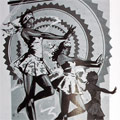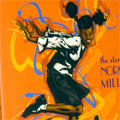Stompin' at the Savoy: The Story of Norma Miller
by Alan Govenar and Martin French (Illustrator)
About
Details: 64 pages, Hardcover, Full-Color, ISBN: 0763622443
Publisher: Candlewick, January 2004
Format: 6.63 x 0.4 x 9.31 in.
Reviews
From School Library Journal
Grade 3-6–This autobiography of a Lindy Hopper from the Harlem Renaissance era sizzles with spirit and swings with vitality. Miller was only five when she knew she wanted to be a dancer, and for a time she lived in an apartment behind the famous Savoy Ballroom. Dancing on the street with friends when she was 12, she caught the attention of the ballrooms top dancer, Twist Mouth George, and soon found herself in contests and shows, eventually traveling throughout the U.S. and South America and appearing in movies. Miller tells her story with humor and candor, describing her mothers disapproval and the tensions of life in show business under a manager, as well as the sheer joy she found in swing dancing. She worked with stars such as Ethel Waters and the Marx Brothers, but also experienced the indignities of Jim Crow segregation. Her feisty, independent spirit shapes her narration, making this an entertaining, compelling read. Stylized black-and-white illustrations, produced digitally and in mixed media, nearly swing right off the pages in their exuberant depiction of dancers and scenes from the Harlem Renaissance, many set over an Art Deco motif. Richard Michelsons Happy Feet: The Savoy Ballroom Lindy Hoppers and Me (Harcourt, 2005) depicts the vibrant scene for a younger audience.
–Joyce Adams Burner, Hillcrest Library, Prairie Village, KS
From Booklist
Gr. 5-8. Govenar, a folklorist, has used his conversations with dancer Norma Miller as the basis of this interesting autobiography. He begins by introducing the adult Miller, now in her eighties, who continues to teach, choreograph, dance, and "swing, baby, swing." In a voice as brisk as a dance step, Miller begins at the beginning: her birth, a few months after her father's death, and her mother's struggle to keep the family together. As a kid, Miller did get one break; she lived in Harlem on 140th Street near the Savoy Ballroom, a popular nightspot where blacks and whites danced, and she would dance outside the Savoy for change. By 12, she was dancing inside, and at 15, she was a professional dancer in Europe. Because of the first-person narrative, explanations are not always complete, especially when it comes to the intricacies of dances such as the Lindy Hop. But the pages turn on Miller's energy, and French's sophisticated ink-and-wash art, with a deco sensibility, has both sass and style.
-Ilene Cooper


